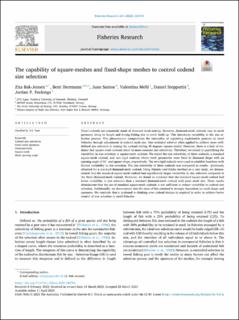| dc.contributor.author | Bak-Jensen, Zita | |
| dc.contributor.author | Herrmann, Bent | |
| dc.contributor.author | Santos, Juan | |
| dc.contributor.author | Melli, Valentina | |
| dc.contributor.author | Stepputtis, Daniel | |
| dc.contributor.author | Feekings, Jordan P. | |
| dc.date.accessioned | 2023-08-10T13:55:20Z | |
| dc.date.available | 2023-08-10T13:55:20Z | |
| dc.date.created | 2023-06-26T14:20:48Z | |
| dc.date.issued | 2023 | |
| dc.identifier.citation | Fisheries Research. 2023, 264 . | en_US |
| dc.identifier.issn | 0165-7836 | |
| dc.identifier.uri | https://hdl.handle.net/11250/3083415 | |
| dc.description.abstract | Trawl codends are commonly made of diamond-mesh netting. However, diamond-mesh codends vary in mesh geometry along its length and during fishing due to catch build up. This introduces variability in the size selection process. This phenomenon compromises the rationality of regulating exploitation patterns in trawl fisheries through adjustments in codend mesh size. One technical solution often applied to achieve more well-defined size selection is turning the codend netting 45 degrees (square-mesh). However, there is a lack of evidence that square-mesh codends result in more constant size selectivity. Therefore, we aimed at quantifying the variability in size selection in square-mesh codends. We tested the size selectivity of three codends; a standard square-mesh codend, and two rigid codends where mesh geometries were fixed in diamond shape with an opening angle of 60° and square shape, respectively. The two rigid codends were used to establish baselines with limited variability in size selection. The size selectivity of these codends was compared to results - previously obtained for a standard diamond-mesh codend. Using Atlantic cod (Gadus morhua) as a case study, we demonstrated that the standard square-mesh codend had significantly larger variability in size selection compared to the fixed diamond-mesh codend. Moreover, we found no evidence that the standard square-mesh codend had lower variability in size selection than a standard diamond-mesh codend with same mesh size. These results demonstrate that the use of standard square-mesh codends is not sufficient to reduce variability in codend size selection. Additionally, we demonstrate that the sizes of fish retained is strongly dependent on mesh shape and openness. We conclude that a profound re-thinking over codend designs is required in order to achieve better control of size selection in trawl fisheries. | en_US |
| dc.language.iso | eng | en_US |
| dc.publisher | Elsevier | en_US |
| dc.rights | Navngivelse 4.0 Internasjonal | * |
| dc.rights.uri | http://creativecommons.org/licenses/by/4.0/deed.no | * |
| dc.subject | Codend size selectivity | en_US |
| dc.subject | Fixed mesh openness | en_US |
| dc.subject | Diamond-mesh | en_US |
| dc.subject | Square-mesh | en_US |
| dc.subject | Mesh opening angle | en_US |
| dc.title | The capability of square-meshes and fixed-shape meshes to control codend size selection | en_US |
| dc.title.alternative | The capability of square-meshes and fixed-shape meshes to control codend size selection | en_US |
| dc.type | Journal article | en_US |
| dc.type | Peer reviewed | en_US |
| dc.description.version | publishedVersion | en_US |
| dc.rights.holder | © 2023 The Author(s). Published by Elsevier Ltd. This is an open access article under the CC BY license (http://creativecommons.org/licenses/by/4.0/). | en_US |
| dc.source.pagenumber | 0 | en_US |
| dc.source.volume | 264 | en_US |
| dc.source.journal | Fisheries Research | en_US |
| dc.identifier.doi | 10.1016/j.fishres.2023.106704 | |
| dc.identifier.cristin | 2158131 | |
| cristin.ispublished | true | |
| cristin.fulltext | original | |
| cristin.qualitycode | 1 | |

